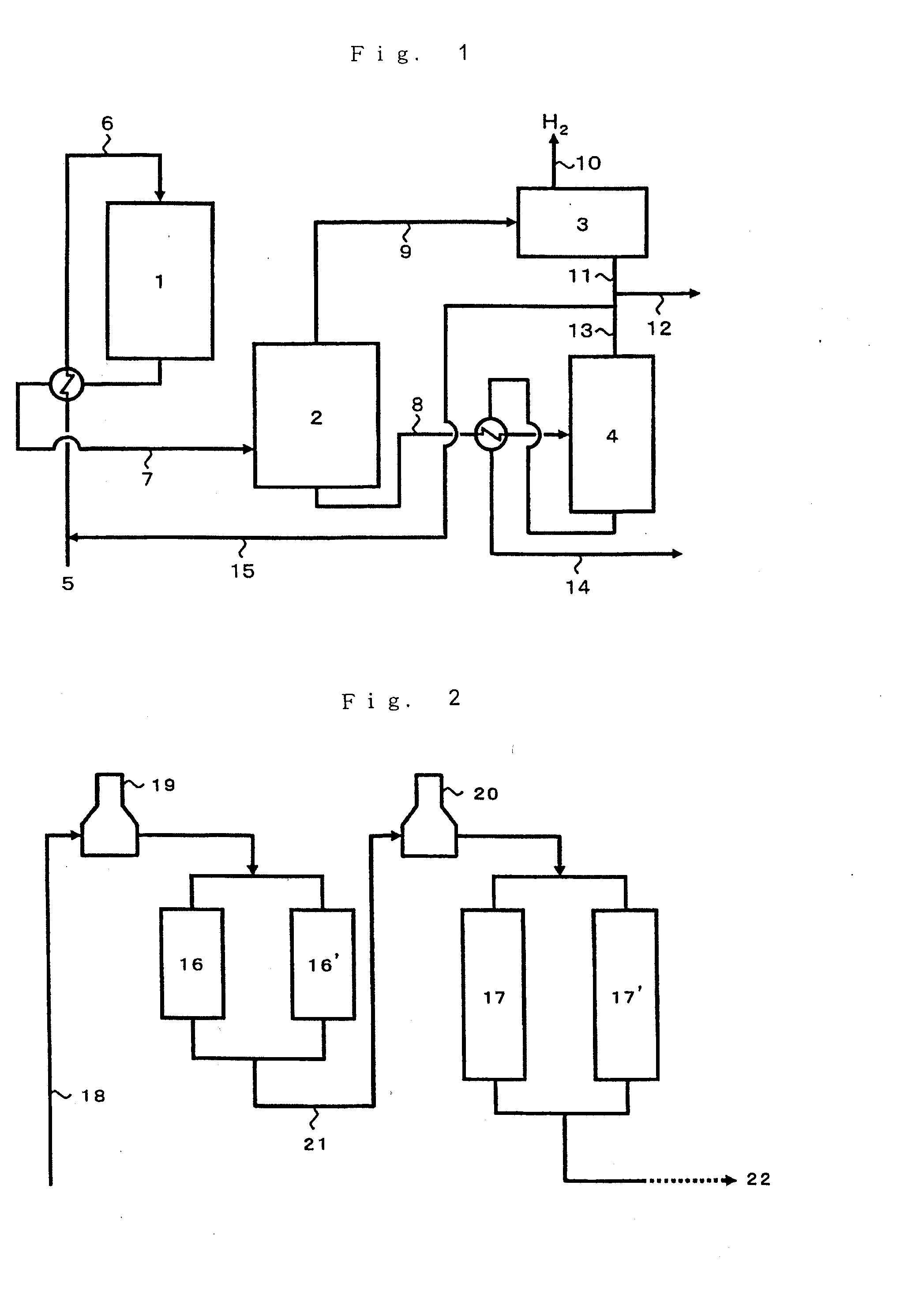Process for Production of Aromatic Hydrocarbons
a technology of aromatic hydrocarbons and hydrocarbons, which is applied in the direction of hydrocarbon preparation catalysts, hydrocarbon oil treatment products, organic chemistry, etc., can solve the problems of reduced octane number of resulting products, difficult to produce high octane, and limited use of light hydrocarbons in petrochemical raw materials, so as to achieve higher yield
- Summary
- Abstract
- Description
- Claims
- Application Information
AI Technical Summary
Benefits of technology
Problems solved by technology
Method used
Image
Examples
reference example 1
Production of crystalline aluminogallosilicate
[0059]Solutions (A) and (B) were prepared. Solution (A) contains 1,706.1 g of sodium silicate [J sodium silicate No. 3, SiO2: 28 to 30 percent by mass, Na: 9 to 10 percent by mass, balance: water, manufactured by Nippon Chemical Industrial Co., Ltd.] and 2,227.5 g of water. Solution (B) contains 64.2 g of Al2(SO4)3.14-18H2O [Reagent special grade, manufactured by Wako Pure Chemical Industries, Ltd.], 32.8 g of Ga(NO3)3.nH2O [Ga: 18.51 percent, manufactured by Soekawa Chemical Co., Ltd.], 369.2 g of tetrapropylammonium bromide, 152.1 g of H2SO4 (97 percent by mass), 26.6 g of NaCl and 2,975 g of water. Thereafter, solution (B) was gradually added to solution (A) at room temperature while stirring. The resulting mixture was vigorously stirred in a mixer for 15 minutes to crush the gel thereby producing a homogeneous fine emulsion. Thereafter, the mixture was put in a stainless steel autoclave and crystallized under conditions where the tem...
reference example 2
Preparation of Catalyst
[0061]Alumina powder (Cataloid AP, manufactured by JGC Catalysts and Chemicals Ltd.) was added to the crystalline aluminogallosilicate produced in Reference Example 1 so that the weight ratio of the aluminogallosilicate:alumina powder is 65:35, followed by addition of water. After the mixture was kneaded sufficiently, it was extruded and then dried at a temperature of 120° C. for 3 hours and calcined at a temperature of 600° C. under an air atmosphere for 3 hours. An about 2 normal ammonium nitrate aqueous solution was added to the extruded product at a rate of 5 ml per gram of the extruded product, followed by ion-exchange at a temperature of 100° C. for 2 hours. After this procedure was repeated 4 times, the product was dried at a temperature of 120° C. for 3 hours thereby producing an ammonium-type crystalline aluminogallosilicate shaped product. The product was made to have a size of 16 to 28 mesh and then calcined at a temperature of 600° C. under an air ...
example 1
[0064]The hydrogen-type crystalline aluminogallosilicate catalyst of Reference Example 2 was used in an amount of 3 ml and packed in an amount of 50 percent by volume (1.5 ml) thereof into each of a first reactor and a second reactor. Using a reaction unit where these reactors are arranged in series, a conversion reaction was carried out at a temperature at the entrance of the first stage reactor of 550° C., a temperature at the entrance of the second stage reactor of 600° C., a pressure at the exit of the final stage reactor of 294 kPa (3.0 kgf / cm2) and an LHSV of 0.8 hr−1 by introducing nitrogen in an amount of 0.7 time by weight of the feedstock naphtha, as a gas simulating a recycle gas. The reaction results are set forth in Table 1 below. The reaction was carried out for 24 hours, and the effluent was analyzed in the same manner as Comparative Example 2. The results are set forth in Table 1.
PUM
| Property | Measurement | Unit |
|---|---|---|
| diameter | aaaaa | aaaaa |
| boiling point | aaaaa | aaaaa |
| boiling point | aaaaa | aaaaa |
Abstract
Description
Claims
Application Information
 Login to View More
Login to View More - R&D
- Intellectual Property
- Life Sciences
- Materials
- Tech Scout
- Unparalleled Data Quality
- Higher Quality Content
- 60% Fewer Hallucinations
Browse by: Latest US Patents, China's latest patents, Technical Efficacy Thesaurus, Application Domain, Technology Topic, Popular Technical Reports.
© 2025 PatSnap. All rights reserved.Legal|Privacy policy|Modern Slavery Act Transparency Statement|Sitemap|About US| Contact US: help@patsnap.com


